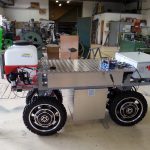[1] J.-M. Bournigal, « Définir ensemble le futur du secteur des agroéquipements », Rapp. Mission Agroéquipements Irstea, 2014.
[2] H. Andreasson et al., « Autonomous transport vehicles: where we are and what is missing », IEEE Robot. Autom. Mag., vol. 22, no 1, p. 64–75, 2015.
[3] S. Blackmore, « Towards robotic agriculture », in SPIE Commercial+ Scientific Sensing and Imaging, 2016, p. 986603–986603.
[4] R. LENAIN, « La robotique agricole : une (r)évolution ? », no ref. article : s7786, 2018.
[5] C. Samson, P. Morin, et R. Lenain, « Modeling and control of wheeled mobile robots », in Springer Handbook of Robotics, Springer, 2016, p. 1235–1266.
[6] A. Bouton, C. Grand, et F. Benamar, « Obstacle negotiation learning for a compliant wheel-on-leg robot », in 2017 IEEE International Conference on Robotics and Automation (ICRA), 2017, p. 2420–2425.
[7] G. Klancar, A. Zdesar, S. Blazic, et I. Skrjanc, Wheeled mobile robotics: from fundamentals towards autonomous systems. Butterworth-Heinemann, 2017.
[8] M. Brunner, B. Brüggemann, et D. Schulz, « Metrics for Path Planning of Reconfigurable Robots in Uneven Terrain », in Informatics in Control, Automation and Robotics, Springer, 2014, p. 147–165.
[9] P. Allgeuer et S. Behnke, « Hierarchical and state-based architectures for robot behavior planning and control », ArXiv Prepr. ArXiv180911067, 2018.
[10] H. Hu, W. Li, et Y. Hu, « Design and research of conceptual function vehicles under TRIZ Theory », in Industrial Engineering and Engineering Management (IE&EM), 2011 IEEE 18Th International Conference on, 2011, p. 97–101.













Commentaires récents